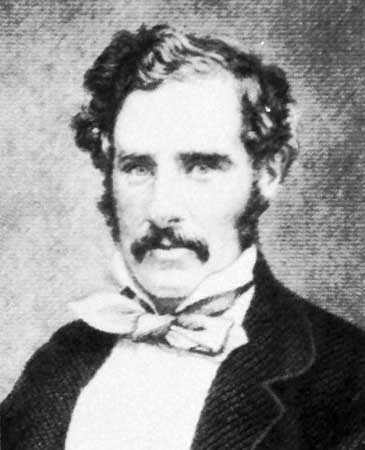George Grey – Explorer and politician

George Grey – Explorer and politician
Posted on
In 1838 George, a young British army lieutenant, led the first land based exploration of the Kimberley. The original plan for the expedition was to travel overland from the Kimberley to the Swan River colony – more than 3000 km. He landed at Hanover Bay late in 1837, just as the wet season was starting. The country was extremely rough and almost impossible for the pack horses to travel over. The weather was pretty bad – unbearably humid at the start, and then wet wet wet. Grey was wounded with a spear on an encounter with a group of aborigines. In the end Grey’s party only penetrated about 50 km south of Hanover Bay before aborting the expedition. Greys expedition would have been considered a failure except for the fact that he was the first European to record the Wandjina paintings of the Kimberley region. for that discovery he gained quite a bit of explorer cudos.
After returning to Perth for a bit, after the Kimberley, he led a second expedition in the north west, intending to explore the area between Shark Bay and the Kimberley and then turn south to the Swan River (Perth). Grey and 11 companions, stores, and 3 whale-boats were offloaded on Bernier Island on February 25th 1839. George ran into all sorts of trouble in the Shark Bay area right from the start – wrecking one of the whaling boats and losing most of their stores in a storm. Instead of exploring up to the North-West Cape (Exmouth) he was forced to turn toward Perth from Shark Bay and limp back along the coast in two damaged whaling boats. South of steep point there was nowhere to land for almost 200 km. Greys exhausted men rowed for 56 hours straight and on March 31 they reached Gantheume Bay, where Kalbarri is now, and decided to land – to rest the men and get fresh water.
The boats were wrecked in the massive surf as Greys men tried to land the boats. They couldn’t be repaired and so the party prepared for a march to Perth. They shared out the remaining provisions – 20 pounds of flour and one pound of salted meat each was all they had for a journey of about 500 km.
At first their way was made pretty easy by the fact that there was loads of fresh water, and they were often able to follow paths made by Aborigines. Interestingly George Grey came upon huts differing from those seen in the north and south of the state. They were larger, more strongly built and plastered on the outsides with clay and turf. Well marked roads, deeply sunk wells and extensive fields of cultivated yams were also in evidence – indicating a relatively resident population. Grey concluded that this semi permanent lifestyle was a reflection of the abundant resources and rich soil of the area. Others have speculated that these features are evidence of Dutch influence on Aboriginal social structure – perhaps the survivors of the Zuytdorp had been this way…
Grey argued with some of his men, who believed that walking only a few miles a day and having rest days was the best way to proceed. Grey was of the opinion that they would not be able to maintain their energy for the longer period of time that such a method would require because of their lack of skill at finding native food. Some of the men carried very heavy loads of goods, taken from the wrecked boats, which they refused to abandon. They planned to sell the goods when they reached Perth. George Grey saw that these men wouldn’t reach Perth at all carrying such heavy loads.
One of those who refused to give up his load was a man called Woods, who on the 10th April lay down and refused to move, declaring that he was dying. Grey, infuriated by Woods and his insistence on carrying his mysterious heavy load to the detriment of himself and the rest of the party, took the load from Woods and unwrapped it, promising to pay him for his treasures. As Grey opened the parcel Woods burst into tears and yelled abuse at Grey. Grey was shocked to find a bunch of junk – a jacket, heavy canvasses, sewing thread and cordage. That this guy was willing to die for a bunch of junk says something about what a desperate state some of the party were in.
By this time Grey’s party was about 190 miles from Perth in a straight line and running very low on flour – their only food apart from what they found. After 7 days they’d walked 70 miles and a number of the men were much weaker than when they started. Most of them were still of the opinion that they ought to proceed slowly and rest often on their journey to Perth but Grey saw that they wouldn’t make it if they continued so slowly. He therefore decided to divide the party and proceed to Perth with the strongest men (6 including him) on rapid long marches. He arranged for the slow party (6 men) to be met by a rescue party, stationed with provisions at the Moore River, 55 miles north of Perth.
Water became very scarce as they moved through barren and arid country. They sucked dew from leaves and some drank their own urine. After three days and two nights with not a drop of water they were on the brink of death when they finally came upon a small hole of moist mud which they drank from – exclaiming that it was the most delicious water they had ever tasted. They were saved for the moment but still starving. April 18 and 19 it rained in the night and the party spent a miserable night in the open freezing cold with no fire. They all wanted to die but kept on going so as to save the lives of the slow party.
Finally, about midway between where Joondalup and Yanchep now are, they came upon a party of natives who were collecting frogs at a dried up swamp. The natives fed them frogs, turtle, barde (grubs) and zamia nuts.
George Grey Arrived in Perth on April 21 in such a state that his friends didn’t recognise him. A search party left Perth on April 23. They found no one at Moore River and went north 25 miles to set up a depot and search for the others. They found Charles Woods wrapped in a blanket sleeping on a beach. He’d left the others at about Jurien Bay, after getting annoyed at their slow progress. The search party looked for a fortnight for the other five men to no avail. They returned to Perth on May 6 to resupply and another search party left the next day. On the 9th May, Mr Walker, one of the missing men, arrived in Perth alone. On the 16th, three men – Ruston, Stiles and Clotworthy, were found in a pitiable state on the beach north of Moore River. They had been without water or food for three days and were close to death.
Frederic Smith (18 years old) was still missing. The others had left him in a very weak state four days prior. Mr Roe and a native man called Warrup found his dead body the next day, about 76 miles north of the Swan River.
Shortly after his return to Perth Grey was appointed Resident Magistrate at King George’s Sound. At 28 years of age in 1840 he was appointed Governor of South Australia, was knighted in 1850 and became Governor of South Africa and twice a Governor of New Zealand.
This just goes to show that you don’t have to be competent to have a successful career in politics!!!



